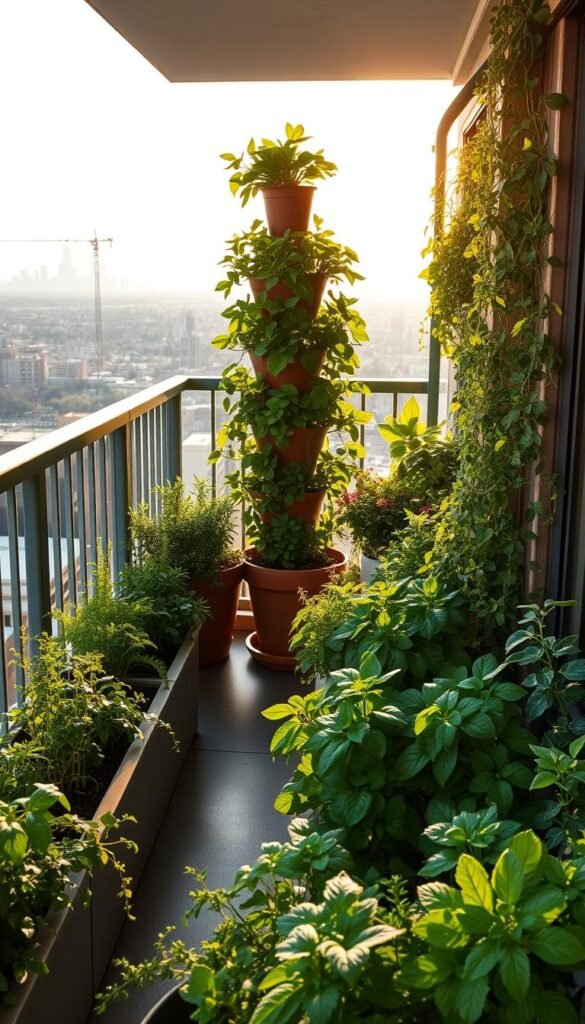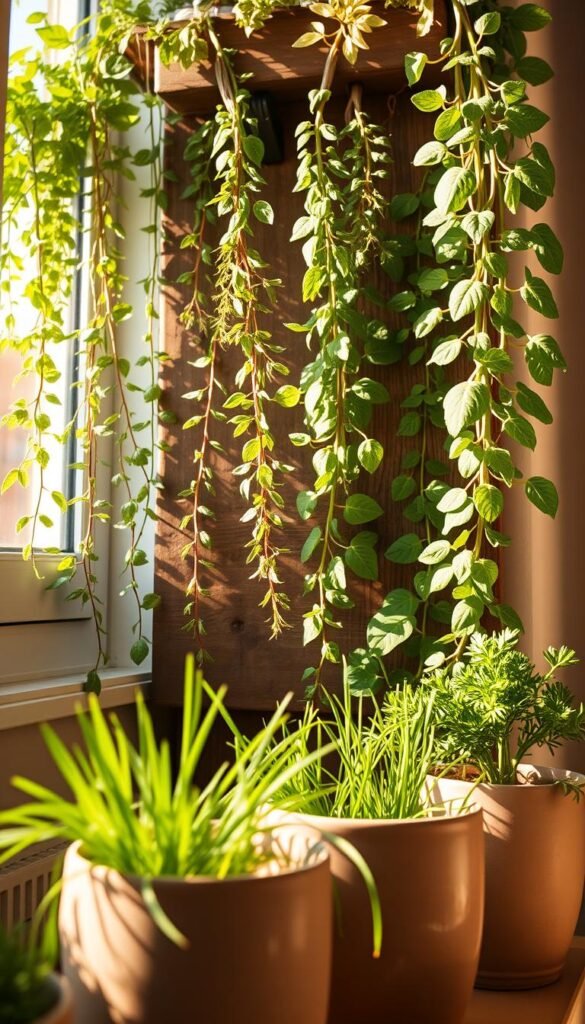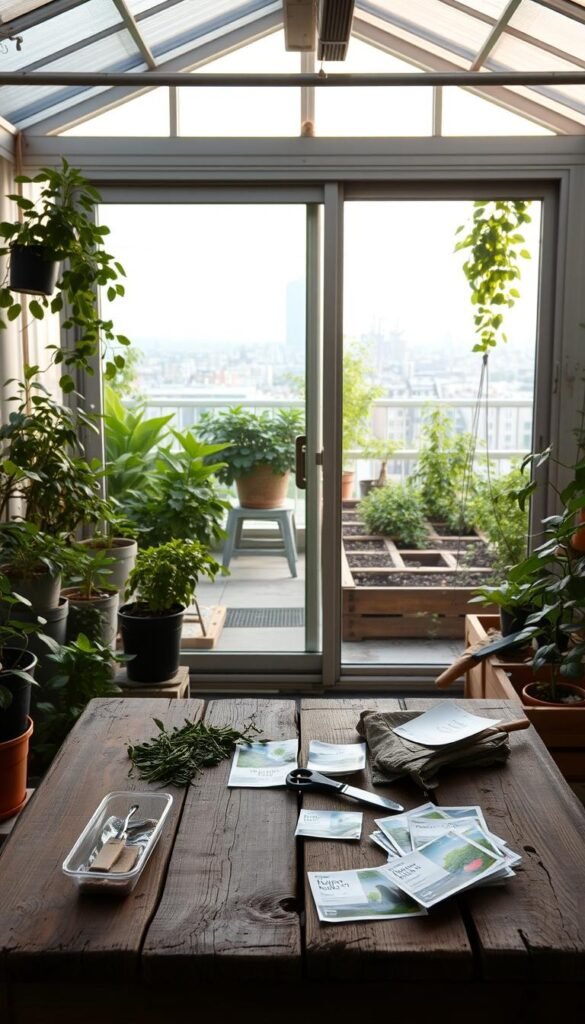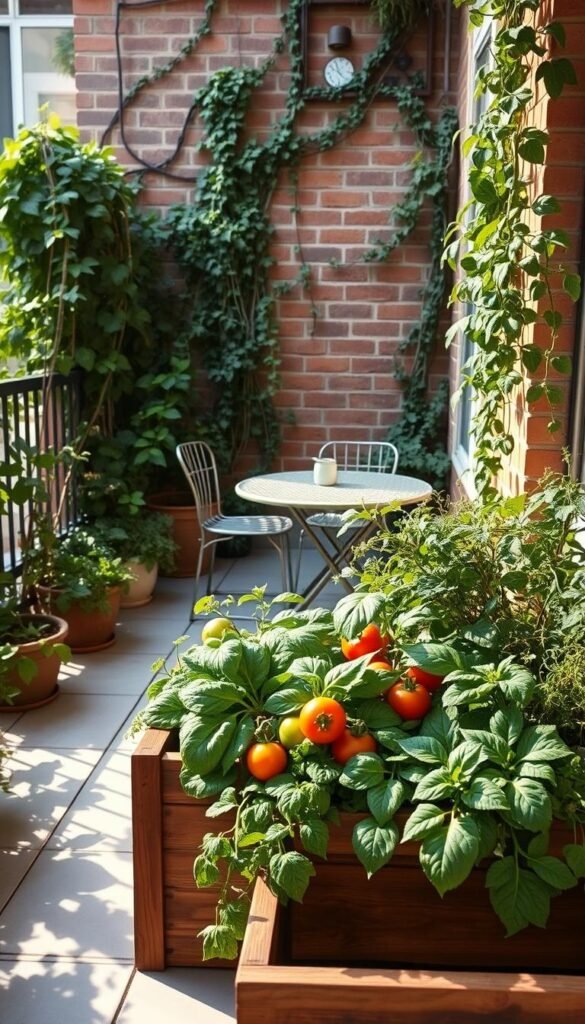Living in a small home doesn’t mean you can’t enjoy fresh, homegrown food. With a little creativity, even urban dwellers can cultivate thriving edible greens right by their windows. This guide will show you how to turn limited areas into productive spots for herbs, leafy greens, and compact crops like cherry tomatoes.
You’ll learn simple strategies to maximize every inch of your space, whether it’s a sunny balcony or a kitchen counter. From choosing the right containers to repurposing household items, we’ll cover solutions that fit busy lifestyles. Best of all, many projects—like regrowing scallions in a glass of water—require minimal effort but deliver satisfying results.
Inspired by DIY enthusiasts and expert growers, these methods prioritize accessibility. No fancy tools or prior experience needed! You’ll discover how nurturing plants can boost your mood, reduce grocery bills, and add flavor to meals. Plus, caring for your green companions becomes a rewarding daily ritual.
By the end of this article, you’ll have a clear roadmap for starting—and sustaining—your own indoor oasis. Let’s dig into the joys of cultivating life, one pot at a time.
Planning Your Space: Layout, Light, and Containers

Transforming your home into a lush green haven begins with smart planning. Before planting, take time to observe your environment—it’s the secret to thriving plants and bountiful harvests.
Assessing Available Space and Sunlight
Start by tracking sunlight patterns. Hold your hand near windows or outdoor areas like balconies at different times. If your shadow is crisp, you’ve got bright direct light—perfect for herbs like basil. Soft shadows mean indirect light, ideal for leafy greens like lettuce.
Measure your space vertically and horizontally. A narrow windowsill can host stacked pots, while wall-mounted shelves turn blank walls into mini farms. One urban gardener shares:
“I use hanging baskets above my kitchen sink—it’s unused real estate!”
Choosing the Ideal Containers and Materials
Containers are your garden’s foundation. Prioritize drainage holes to prevent soggy roots. Self-watering pots work wonders for busy schedules, while repurposed mason jars add charm to herb collections.
| Material | Best For | Tip |
|---|---|---|
| Terracotta | Succulents | Add gravel at the base |
| Fabric Bags | Root vegetables | Promotes air flow |
| Plastic | Moisture-loving plants | Reuse food containers |
Pair containers with the right soil. Use a well-drained mix for herbs, and moisture-retentive blends for ferns. For small spaces, try compact elevated planters—they save your back and look chic!
If natural light is scarce, grow lights can help. LED strips under shelves mimic sunlight, ensuring seedlings never stretch weakly toward windows. Remember: even urban jungles need thoughtful design to flourish.
Apartment Gardening Tips: Grow Vegetables in Tight Quarters

Small-space success blooms when you match greenery to your environment. Focus on varieties that naturally adapt to containers and limited light. With thoughtful selection, even a windowsill becomes a powerhouse of fresh flavors.
Selecting Vegetables and Herbs Suited for Small Spaces
Dwarf varieties like ‘Tiny Tim’ tomatoes thrive where others struggle. Fast-growing greens such as arugula and spinach give quick rewards—some ready in just 30 days. For continuous harvests, try cut-and-come-again lettuces that regrow after trimming.
Herbs reign supreme in compact setups. Basil and parsley love sunny spots, while thyme and mint tolerate lower light. One gardener shares:
“My cilantro grows better in shallow pots than it ever did in my backyard!”
Incorporating Container and Vertical Gardening Techniques
Stackable planters turn walls into edible displays. Use hanging pockets for strawberries or trailing nasturtiums. Pair vertical systems with self-watering bases to save time between busy days.
| Container Type | Best Plants | Space Saved |
|---|---|---|
| Tiered Planters | Leafy greens | 70% floor area |
| Wall Pockets | Herbs | Vertical surfaces |
| Hanging Baskets | Cherry tomatoes | Overhead areas |
Water deeply but less often—most plants prefer thorough soaking every 3-4 days. Morning routines work best, giving roots hours to absorb moisture before lights dim. Remember: small spaces demand big creativity, not big budgets!
Indoor vs. Outdoor Strategies for Urban Gardeners

Urban living offers unique opportunities to blend nature with your daily routine. Whether you’re nurturing herbs on a kitchen counter or tomatoes on a fire escape, smart choices make all the difference. Let’s explore how to balance controlled indoor setups with sun-drenched outdoor spots for year-round freshness.
Creating a Thriving Indoor Garden
Start by choosing sleek pots with drainage holes—ceramic or resin work best. Place them near south-facing windows where greens like kale and spinach soak up 6+ hours of light daily. No sunny spots? LED grow lights mimic natural spectra, helping seedlings grow well even in dim corners.
Self-watering planters are game-changers for busy schedules. Pair them with moisture meters to avoid overwatering. For herbs like basil, try compact smart gardens with built-in timers. One gardener raves:
“My countertop system grows parsley faster than my backyard ever did!”
Maximizing Balconies, Patios, and Other Outdoor Areas
Even a 3-foot patio can burst with life. Use tiered planters to stack flowers like marigolds alongside edible greens. Hanging baskets save floor space while letting trailing strawberries bask in sunlight. For windy spots, secure pots with adhesive hooks or lattice panels.
Vertical pocket gardens transform blank walls into lush displays. Rotate plants grow toward the sun every few days for even exposure. Portable wooden greenhouses extend your season, shielding tender shoots from early frosts. Remember: small space success thrives on creativity, not square footage!
Nurturing Your Green Space: Watering, Soil, and Fertilizer Essentials

Your thriving indoor garden relies on three pillars: smart watering, nutrient-rich soil, and balanced feeding. Let’s explore how to create a strong foundation for your plants to flourish.
Building Healthy Foundations
Drainage is non-negotiable. Always choose containers with holes at the bottom—add a layer of gravel or perlite to prevent clogging. Gardener’s Supply Co. recommends using potting mix blended with 30% compost for vegetables like beans. This combo retains moisture while letting roots breathe.
Organic amendments work wonders:
- Worm castings boost nutrient levels
- Coconut coir improves water retention
- Blood meal adds nitrogen for leafy greens
| Fertilizer Type | Best For | Application |
|---|---|---|
| Fish Emulsion | Fast-growing herbs | Every 2 weeks |
| Bone Meal | Root vegetables | Mix into soil |
| Compost Tea | All plants | Monthly soak |
Water Wisdom Made Simple
Stick your finger 1″ into the soil before watering—if it’s damp, wait. Self-watering containers with reservoirs are perfect for busy schedules. Pair them with cool vapor humidifiers to maintain 40-60% humidity near sun-loving plants.
Rotate containers weekly so all sides get equal sun exposure. During summer, water early to reduce evaporation. One urban grower shares:
“I use recycled yogurt cups as moisture meters—they tell me when it’s time to water!”
Refresh soil mixes every season, adding fresh compost to replenish nutrients. With these basics mastered, your green space becomes a low-maintenance haven bursting with life.
Overcoming Challenges and Enhancing Your Garden Experience

Every urban grower faces hurdles, but solutions are simpler than you think! Whether you’re battling tiny invaders or working with dim corners, smart strategies keep your plants thriving. Let’s tackle common obstacles and turn them into opportunities for growth.
Smart Solutions for Everyday Struggles
Pests love fresh greens as much as you do. Wipe out aphids with a mix of water and dish soap, or place sticky traps near seedlings. For fungus gnats, sprinkle cinnamon on soil—it’s a natural fungicide. One gardener notes:
“Covering my basil with mesh kept bugs away without chemicals!”
Low sunlight? Position plants near east-facing windows for morning rays. Use LED grow lights 12 inches above herbs for 14 hours daily. Rotate pots weekly so all sides get equal exposure.
Keeping Your Harvest Rolling
Replace harvested plants immediately to maintain productivity. Try this schedule:
| First Crop | Follow-Up | Days Between |
|---|---|---|
| Radishes | Spinach | 25 |
| Lettuce | Bush Beans | 30 |
Mix fast-growing varieties like baby kale with slower ones like carrots. For beginners, start with forgiving plants like scallions—they regrow after cutting!
Always use pots with proper drainage holes. Add perlite to potting mix for better airflow. Water when the top inch feels dry—overwatering causes more issues than neglect. Remember: each challenge mastered makes your green thumb stronger!
Your New Garden Journey: Enjoy Bountiful Harvests
Your journey into urban cultivation starts with a single pot—and grows into something extraordinary. By now, you’ve mastered planning layouts, selecting seeds, and nourishing plants with the right fertilizer. These skills transform even the tiniest area into a vibrant source of fresh flavors.
Celebrate the magic of watching basil sprout from seeds or cherry tomatoes blush under your care. With smart soil mixes and timely feeding, your compact setup rivals larger plots. Remember: creativity thrives where space doesn’t. Try stacking planters or swapping crops seasonally—every experiment sharpens your green thumb.
Struggling? Revisit our beginner’s guide to small-space cultivation for quick refreshers. Share your wins—like that first homegrown pepper—to inspire others. Each harvest proves that limited square footage can’t limit joy.
Keep learning. Rotate crops, test new fertilizer blends, and explore heirloom seeds. Every inch of your area holds potential. As you nurture life in unexpected places, remember: your patience and care are already yielding something beautiful. Here’s to many seasons of growth ahead!






